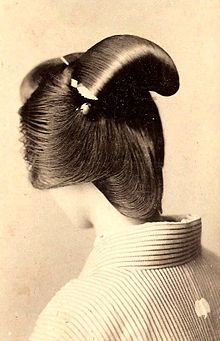This article needs additional citations for verification. (July 2020) |

Nihongami (日本髪, lit. 'Japanese hair') is the term used for a number of traditional Japanese hairstyles considered to be distinctive in their construction and societal role.
Traditionally, the construction of most nihongami hairstyles consisted of two "wings" at the side of the head, curving upwards towards the back of the head to form a topknot or ponytail, with a long loop of hair below this also drawn into the topknot. Styles were accessorised with traditional hair accessories, though typically only by women; the combination of both style and accessories formed hairstyles that distinctively varied based on gender, age, job role and social standing.
Most styles of nihongami were hardened and shaped with wax, known as abura, and were styled with specially-carved combs made of either bamboo or boxwood, with heated tongs used to straighten the hair before styling. Hair styled in this manner was typically restyled weekly, and in some cases would necessitate sleeping on a pillow raised from the floor, known as a takamakura.
Nihongami are no longer commonly worn, and today are most often seen on maiko, geisha and sumo wrestlers. A number of different styles of nihongami are also worn by courtesan re-enactors and modern tayū, and many styles once common in the Edo period are seen faithfully reproduced in kabuki plays, which themselves also commonly date to the Edo period. Though some styles of nihongami are well documented, others have, over time, fallen into obscurity, with little in the way of documentation in regards to their appearance, name, origin and method of styling.